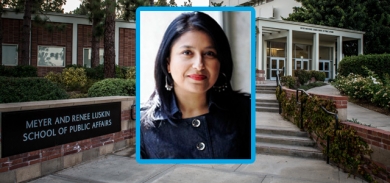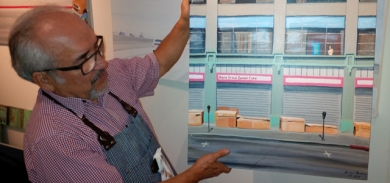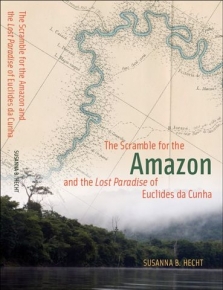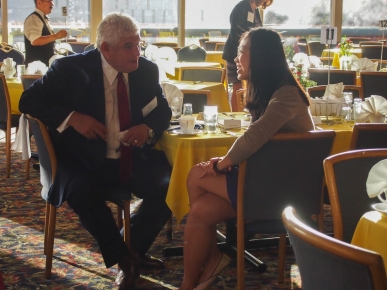On October 6, Richard Kauffman, Chairman of Energy and Finance at the New York State Office of the Governor, and Mary Nichols, Chairman of the California Air Resources Board, spoke with Dr. J.R. DeShazo of UCLA’s Luskin School of Public Affairs and Luskin Center for Innovation at the GloSho 2014 opening plenary titled, “Fireside Chat: Two Clean Economy Titans.” MIR presents edited excerpts from the conversation, focused on the public sector’s catalyzing role for innovation in both the California and New York clean-technology private sector. Reprinted from The Planning Report.
J.R. DeShazo: What are the policy rollouts that are most important for private sector participation, in order to achieve climate change policy goals?
Mary Nichols: If there is one criticism I would make about our metrics in California, which I usually brag about, it is that we’re doing too much—not that we’re doing too little.
It’s hard for people to understand which proceedings they should participate in, where to go, and which agency to talk to. They’re all doing interesting and important things in many different sectors. We’re trying to address that issue in this administration through the work of the four energy agencies. It is amazing that, thanks to AB 32, the Air Resources Board is now considered an energy agency—even though for years we were doing work that had an impact on energy but were not ever considered to be leading in that space.
I think those working in California for a long time have just gotten used to the fact that we’ve got the PUC, the Energy Commission, the Air Resources Board, and the ISO all involved, spending money, passing regulations, and coming out with policies. Every one of these agencies and all of the programs that we have, going back to the Pavley Standards and the first carbon registry in California, are now clearly coming together under the umbrella of climate change. We obviously want to—and must—keep the lights on. Of course, it needs to be affordable. Everyone is in agreement that by 2050, around 80 percent of all carbon and GHG emissions have got to be out of our economy. That is going to take a very big effort. Starting now, we have to find ways to get ourselves there.
Richard Kauffman: I’ve been in the private sector and I know quite a bit about markets. I’ve been a clean-tech investor, so I know that the issues are less about technology, although we certainly need more innovation in technology. But there are plenty of good technology solutions.
The real problem is that there are tons of market constraints and market failures that prevent solutions from coming to life.
Generally, the energy sector is the most mature sector in the economy. It enjoys tremendous scale advantages. The utility industry is regulated, and in many cases, some fundamental regulations have not changed since the time of Edison. Understandably, there is a degree of conservatism about energy and electricity. We want lights to keep going and we want it to be safe. There are lots of issues that are appropriately conservative, but we have to get close and careful to see where the market barriers are.
We also have to do the same thing with government policy. Sometimes when we give grants, the grants don’t lead to new markets or businesses. The government becomes the market.
In New York, we’re trying to have a heavily market-led approach. In terms of our utility sector, we want to change the utility incentives so they are focused on having higher capacity utilization. Right now, the utility sector has 55 percent capacity utilization. How many industries that are capital intensive have 55 percent capacity utilization? None.
There has been a revolution in the last 20-30 years about different business models, adaption technology, and changes in financial incentives, but they have not yet come to the electric utilities sector. That’s because the regulatory incentives haven’t changed. We pay utilities, and the way they get their profits is through getting a regulated return on capital. We can’t be surprised that we have low capacity utilization. We should think about the utilities as getting paid for efficiency, and we stimulate third party app providers to create competitive markets around customers.
You need to draw in innovation to the end market and build the system from the customers-out as opposed to being a push model. With respect to government policy, I’ll give you one example: our residential energy-efficiency program. 70 percent of the houses in New York State are more than 70 years old, so there is a lot of opportunity to get energy efficiency from houses. We have a grant for somebody to do a residential audit, so residents don’t pay for that—ratepayers do. You can get a grant for up to 20 percent of the cost for the retrofit depending on your income. At the current rate of penetration of those programs, it will take 1,000 years.
We’ve got to change government policy and programs so they can stimulate the market. The way to do that is to think about community aggregation. We want to focus the grants on the reduction of soft costs, and customer acquisition and financing costs rather than being the only source of their financing and support.
Audience Question: As Chairman Kauffman mentioned, New York’s new energy vision has utilities rewarded more based on performance. Do you see California taking a similar approach?
Mary Nichols: That’s been the philosophy for quite a long time. Our overall policy has been to separate the ability of utilities to make money from the fact that they need to provide energy-efficiency services.
California has been the first state—now fortunately joined by many others—to separate the ability of utilities to get real return from the amount of sales of their product and pay them for energy-efficiency programs. That’s been probably the most fundamental change that we’ve made from early on.
The directive is to the utilities, but also there is a financial incentive built into it. We are leading in terms of work that we get in our economy and our homes out of kilowatt hours of electricity. We are extremely energy efficient. But there is still a long way to go. There is no question that we need to develop some new and more effective ways of delivering retrofits of existing buildings and such, as Chairman Kauffman was talking about.
The key thing here is that the electric utilities themselves are not the only providers of these services. The market must make it possible for others to function effectively in that space—especially when some utilities are regulated by the Public Utilities Commission and others are regulated by their local governing boards. The legislature has been struggling with this for a while, in terms of how they can set the right kinds of standards that will get the market to work better and get regulations to not be an impediment, but a better inducement.
We’ve gotten a lot better in the transportation sector. The larger share of energy that we use in California goes to moving ourselves and stuff around our state, and the biggest sector of our economy is moving goods around.
We need to think more broadly about the relationship between electricity and natural gas as providers of electricity and providers of transportation. That’s where a lot of the new thinking is going on right now—how to make that crossover work.
J.R. DeShazo: For those unfamiliar, the chairwoman was referring to a decoupling policy adopted in the early ’80s by the CPUC.
Richard Kauffman: I am immensely respectful of all the things that the chairwoman has said. The great thing about states, as Brandeis said, is that they are laboratories of democracy. It’s fantastic that states have been experimenting with things. California has been a leader.
We have decoupling in New York, and what we’re talking about is going beyond California. The issue with decoupling is that it makes utilities indifferent as to the quantity of electricity their customers consume. It doesn’t create a proactive incentive for system efficiency or for things that relate, as Chairwoman Nichols said, to what is going on around customers.
New technology is providing opportunities to think about what it means to be a utility in terms of monopoly. The whole concept of a monopoly depends on the collective being cheaper than the individual. But if the technology changes so that the individual becomes cheaper than the collective, the logic begins to break down.
In Brooklyn, which is growing very rapidly, ConEd the utility would have spent $1 billion for a new substation—which would add about 55-57 percent capacity utilization, built for the hottest few hours or days of the year. That’s a lot of money paid for by all ratepayers, in terms of rates and power costs, which are very high in New York State in the summer and, increasingly, in the winter.
The alternative, which is now going to happen, is that instead of that $1 billion investment, they will be providing power through distributed generation using natural gas, solar, and demand-response energy-efficiency measures. That will cost ratepayers less and will result in a cleaner, cheaper system.
The way it’s being implemented is interesting: Utilities released enough data so that they’re getting all kinds of innovation from the market about how to solve this problem. We’re going to create competitive markets around customers. We’re going to free up data and let a whole variety of service providers come in with a whole variety of solutions that are going to help the utility become more efficient, but also help provide more choices and variety to customers.
Audience Question: What is the onramp for entrepreneurial technology companies that wish to deal with utilities in California?
Mary Nichols: To pick up on what Richard was saying, it’s not going to come from the utilities themselves, clearly. Government policy does play a critical role here in enabling the implementation of new technologies.
I think the source of innovation about financing and providing energy services is coming through the ISO. It is creating new markets for services other than plugging new plants into the system and getting power purchase agreements through the utilities. They are partnering with the Public Utilities Commission and the Energy Commission, in terms of allowing for other ways of services provision and other ways of demonstrating that the lights will stay on.
I completely agree that the solution for the longer term is not just about building more plants. We’re actually dealing now with the issue of what to do when there is an oversupply of electricity at certain times of the day and the year. That’s a small issue now but is going to be a much bigger one in the years to come, as we bring online more solar, wind, geothermal, and other facilities.
Instead of being worried about whether there will be enough to serve the demand at peak times, we are now worried about shedding load, which is a waste and a bad thing to do from an economic perspective. We’re thinking about how to make sure those electrons are being stored and used appropriately.
From the state’s perspective, we’re trying to responsibly look at the whole system and allow it to balance itself in the most efficient possible way.
J.R. DeShazo: I would add—because it’s sort of taken for granted in Chairwoman Nichols’s remarks—that if you’re a utility today in California, you have a set of push and pull factors. The push factors are the RPS and other state legislative requirements. The pull factor is the cap-and-trade program, which is changing the price of your kilowatt-hours as a function of the carbon content. Those incentives are acting actively now in California.
Richard Kauffman: I would add that when we’re thinking about clean-tech, we have to allow for the possibility that not everybody is motivated by saving the planet or saving money on electricity. When Edison helped set up the electricity system, he thought it was only going to be about lighting. Even in his own lifetime, he saw it become much more than just lighting.
I think the technology you guys are all developing provides a lot more value potentially for the electricity system than we have today. Nobody gets up and says, “I want to make more electricity.” It’s what the electricity system provides in terms of value.
I talk to healthcare companies that say, “We want to improve the quality of home health care and reduce costs by at-home health care monitoring. That’s going to require a home automation system.” Apple wants to provide more entertainment through a home automating system. The drivers for a new electricity system could be convenience, comfort, and health. That has potential for a much more energy-efficient system, but the driver may be other things than just saving money. That’s why it’s so important to get innovation in the market.
Audience Question: Chairman Kauffman, I want to thank you and NYSERDA for funding a grant that my company seeded in early 2000 to study a hybrid biogas wind program for Wyoming County. Now, we’re faced with those issues in the Central Valley—yet, we have not seen the whole commercialization of biogas to reduce methane, to reduce NOx precursors, and the associated water issues. What are your agencies doing to promote those solutions?
Richard Kauffman: I think you have identified a classic problem of how we need to evolve our government policy. These projects would be supported by a grant here or there. It’s not really creating a market. I’m not saying that grants or incentives may not be necessary, but is that the only mechanism that we’re going to use?
We’re working in this area to make sure that the projects are really local. Is the cost for the developer and the customer acquisition cost really high? If you lower the developer cost, you’re going to get more projects done.
How do you lower the development cost? One way is to identify if projects are located next to something else—and whether the gas or electricity could be useful to the rest of the system. Let’s develop projects where it’s going to be better for the system.
How can we get local communities or governments involved in this, where there are opportunities for them to save money? Right now, each local government has to figure it out on its own. Is there a way to create a mechanism where there are off-the-shelf solutions that local governments can use? Government can do things like convening, which doesn’t cost a lot of money.
Another example is financing. Project financing is difficult for small projects. This isn’t about subsidized financing. We have a green bank that can do things like provide an aggregation facility for financing. These projects are just a few millions dollars—and it’s very hard to get a bank interested in that kind of money. But if the green bank can provide an aggregation facility, then you can actually provide the financing market for the private sector.
Mary Nichols: This is not in any way to dismiss the abstract of what you’re saying. But I want to focus on the practical problem of methane and dairies as a practical example of the range of issues involved and how the right mix of policies, regulations, and standards are necessary elements of the overall solution that will also drive investment.
We have dairies in the Central Valley of California that are located near each other. We’ve actually had dairy owners willing to volunteer to try to host digesters on their land.
We have a problem with nitrate in the water, and we have a problem of needing renewable natural gas. We have a problem of wanting to get methane out of the air. So we have all these reasons why we would like to make this system work.
We can set pipeline standards to get this stuff into the pipeline. We can promote the best technology that is now in the early stages.
We can’t make it economical for the dairy owner to truck the waste from the cows to a central location. The cows in the dairies are not located in a place where it’s convenient to put in some megafacility all in one place. We actually need to create, or have someone create, a company that would go out there and work to finance these things—aggregating a lot of these projects together. That would be the sensible market solution.
But until there is a sense that there is a long-term commitment to this—that there’s money out there to help finance it, there are regulatory tools in place, and targets that they’re going to meet (probably in terms of the nitrate standard for the underground water supply)—it’s not going to come together. Not to say that this isn’t the way it should go— just to say it’s going to take, still, a lot of work on the part of a lot of people to implement a solution that we all know is the right thing to do.








